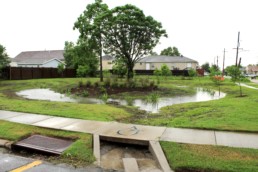In New Orleans, the Gentilly Resilience District project is transforming the approach of urban water management while beautifying neighborhoods.
Implemented in 2016, the Gentilly Resilience District project is transforming streets, parks, schoolyards, open lots, and homes by facilitating the construction of green roofs, bioswales, and pervious pavements throughout the city. With flooding and slow land subsidence posing a significant threat to the city, the aim is to capture and store rainfall in the urban environment. The project adopts a suite of approaches, acknowledging that one solution is not enough to ensure a secure future for New Orleans in a changing climate.

The initiatives under the Gentilly Resilience District project not only capture rainfall but help to beautify neighborhoods, encouraging more recreational activities and improving walkability. The project also benefits the significant portion of city residents who are unemployed, in particular the 52% of African-American males of working age, with new job and training opportunities in water management specifically targeting this group.
350 individuals engaged in the development of the resilience strategy in 2015, which directly informed the creation of the project
The challenge
New Orleans faces threats of flooding from intense rainfall events and sinking soils, which exacerbate the flood risk. The urban heat island effect is also an issue due to the quantity of unnatural surfaces. The city has found a solution through various gray and green infrastructure solutions that collect rainfall and, as an added bonus, address the urban heat island effect.
Co-benefits
Economic Each dollar spent on the Gentilly Resilience District project will result in more than one dollar of estimated benefits through improved property values, reduced flood risk, avoided costs to infrastructure maintenance, environmental value, and recreational benefits.
Environmental The project will improve water quality through natural filtration of pollutants, improving the health of the whole ecosystem.
Health Due to the reduction of water standing in urban in environments for prolonged periods of time, the Gentilly Resilience District project prevents mosquito-borne illnesses.
Social Heat islands in the city will be reduced through the reduction of impervious surfaces and increased shade, lowering local temperatures and encouraging more people to be outside.
About New Orleans
New Orleans is a major United States port and the largest city and metropolitan area in the state of Louisiana. The population of the city was 343,829 as of the 2010 U.S. Census. It is well known for its distinct French and Spanish Creole architecture, as well as its cross-cultural and multilingual heritage. New Orleans is also famous for its cuisine, music (particularly as the birthplace of jazz), and its annual celebrations and festivals, most notably Mardi Gras, dating to French colonial times. The city is often referred to as the “most unique” in the United States.


